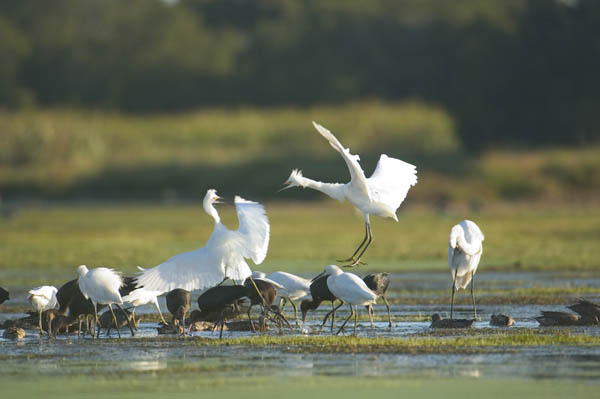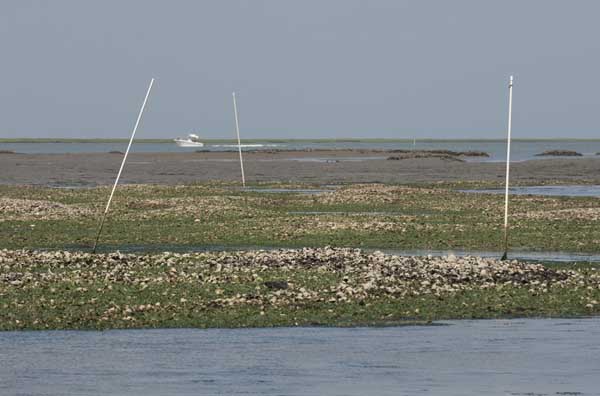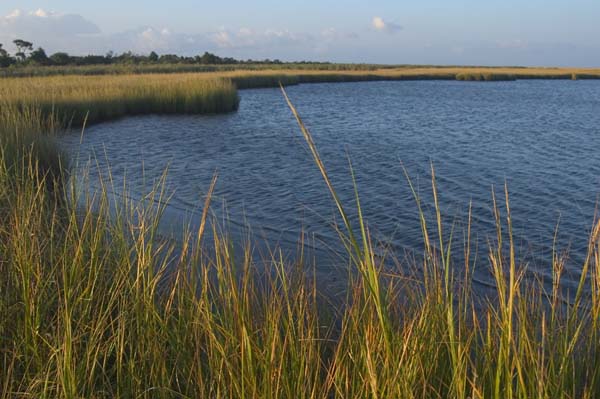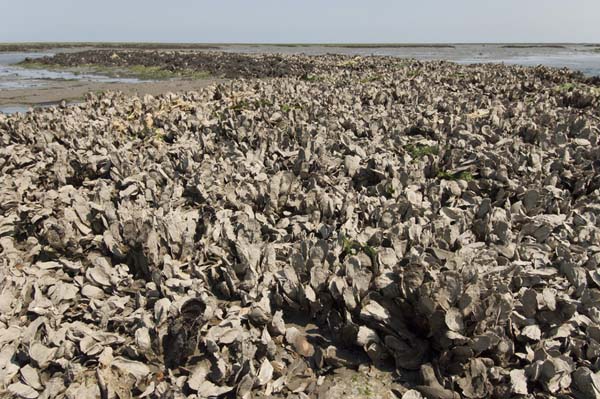Oysters filter nitrogen from water — and nitrogen pollution is a huge and growing problem along many coastlines, not just for the United States, but worldwide.
So could restoring oyster reefs combat nitrogen pollution? And if the answer is yes, could that service generate enough funding for broad-scale oyster restoration?
A team of scientists is investigating those questions at the Nature Conservancy’s Virginia Coast Reserve — fittingly, just offshore from Oyster, Virginia — developing crucial data on just how much nitrogen oyster reefs can take out of the water.
Their findings may aid in the recovery of oyster reefs across the country. That recovery may in turn spur the revival of estuaries — and the economies that depend on them — from Willapa Bay in Washington, to Chesapeake Bay, to the Gulf of Mexico.
“If we do it right, restoring oyster reefs can be a big part of how we reduce the amount of nitrogen and other nutrients in estuaries like Chesapeake Bay,” says Lisa Kellogg, a researcher at the Virginia Institute of Marine Science and the leader of the team working in the Virginia Coast Reserve.
THE PRESSING NEED TO REDUCE NITROGEN POLLUTION
Oyster is a tiny settlement on the Atlantic Ocean near the southern tip of the Delmarva peninsula. When people say a town is built on some industry or resource, they almost always mean it figuratively. Hershey, Pennsylvania does not rest upon a mountain of chocolate. Bad math does not hold up the walls of Las Vegas casinos.
Oyster is different. Scrape the ground here and you find oyster shell. Without oysters, there would have been no town here at all –– no buildings, no boat ramp, not even a harbor, which was dredged to provide access to the shellfish beds offshore.
Those oyster shells were the product of many generations of oyster harvesting. Now only a tiny fraction those oysters remain. Yet, Oyster is still a working town, though the bivalve of choice are now clams. Earlier this summer, the scientists a joined the commercial clammers on the town’s boat ramp.
Unfortunately, you do not need scientific expertise to see the need to reduce nitrogen pollution here in Oyster and elsewhere in and around Chesapeake Bay—or in many parts of the world.
When nitrogen reaches the Bay or any other shallow estuary –– as run-off from agriculture, as untreated sewage, or in the emissions of power plants and factories –– it provides nutrients for phytoplankton, which bloom effusively and then die and sink to the bottom. Bacteria break the plants down and in so doing suck much of the oxygen out of the surrounding water, killing the fish, crabs, shellfish, seagrass and just about everything else. As a result, when plankton blooms reach their summer peak, about two-thirds of the Bay is a dead zone.
The problem is far bigger even than that. Just in the US, the Mississippi River gathers runoff from millions of acres of farmland, and the nitrogen and other nutrients that pour into the Gulf of Mexico creates a dead zone every summer that can cover more than 8,000 square miles, and area the size of New Jersey. Worldwide, there are some 400 dead zones, and scientists expect that number to rise.
1,300 ACRES OF OYSTER REEF COULD EQUAL A STATE-OF-THE-ART WATER TREATMENT PLANT—AT FAR LESS COST

The science team in Oyster has reason for at least cautious optimism: Kellogg found in earlier experiments that under the right conditions, an acre of restored oyster reef could remove nearly 500 pounds of nitrogen from the water per year, more than anyone had shown anywhere in the Bay and one of the highest ever reported in any marine environment.
At that rate, restoring about 1,300 acres of oyster reef would be about the same as building a state-of-the-art water treatment plant. That may sounds like a lot, but there are many thousands of acres in the Bay that could potentially support restored oyster reefs.
That result stirred considerable excitement. Under the Clean Water Act, communities must reduce the amount of nitrogen flowing into rivers and estuaries. Faced with the possibility of needing to build new water treatment facilities at the cost of hundreds of millions of dollars to get into compliance with the law, the idea of using oysters instead may well make economic and ecological sense.
“We have been chasing the denitrification argument for some time,” says Boze Hancock, a marine scientist with The Nature Conservancy. “Denitrification is one of the service that oyster reefs provide for us, and one of real value,” he says. But Hancock also adds a note of caution: the state of most oyster populations are so dire that it will take time for them to really contribute. “We have a lot of work to do to get these systems back on their feet before reefs are relevant to reducing nutrient pollution.”
HOW DO OYSTERS TAKE NITROGEN OUT OF THE WATER, ANYWAY?

To reduce an exceedingly complex system to a simple schematic: oysters filter the water above them and consume the phytoplankton and other bits of organic matter. Some of the nitrogen in the plants ends up in the oyster itself or in its shell, and the rest gets excreted and lands on the sediment around the reef, along with everything else the oysters filter out of the water but do not actually eat.
Once there, aerobic bacteria living in the top layer of sediment and anaerobic bacteria deeper down transform the nitrogen in a series of steps that end with some of it being released as nitrogen gas, the most abundant element in the air we breathe.
Oysters are the key link in the denitrification system. There are plenty of phytoplankton in the water and plenty of bacteria in the sediment, but they need to be connected by oysters.
The reefs provide other benefits as well, like protecting shorelines, providing food and habitat for fish and filtering water so more light reaches the bottom thus encouraging the growth of seagrass.
MAKING AN AIR-TIGHT CASE FOR THE WIDESPREAD DENITRIFICATION BENEFITS OF OYSTER REEFS

Kellogg’s earlier results were exciting, but do not definitively make the case for oyster restoration as the key to solving the nitrogen problem. Now the scientists want to see if comprable denitrification rates occur on reefs with lower densities and in shallower water.
The area directly offshore from Oyster provides an ideal setting for that research. Most of the area is protected, forming part of The Nature Conservancy’s expansive Virginia Coast Reserve (VCR).
VCR protects undeveloped barrier islands, thousands of acres of pristine salt marshes, tidal mudflats, shallow bays, and productive forest uplands. Included within that complex are five oyster reserves, among the first such protected areas in the United States set aside specifically for oysters.
The existence of the oyster reserves was essential for the current experiment. Kellogg and her team wanted to start from scratch on a stretch of seafloor with no oysters, so they could set up a series of experimental plots seeded with varying densities of oysters and then measure the differences among them. Working with Conservancy staff, they selected an area about half a mile from shore that is flat, soft, and almost completely dry at low tide.
Measuring changes in nitrogen on a living oyster reef is tricky business. Through some painstaking steps, Kellogg’s team bring small pieces of the reef into the lab and use sensitive instruments to measure various characteristics of the section of reef, including concentrations and fluxes of nitrogen, oxygen, phosphorous.
But that work is only half the story. The researchers are not just interested in the oysters, but all the other creatures that live in the reef and also play a role in the complex denitrification process. Getting a handle on that part of the question is why in mid-July the team was loading gear in two Carolina skiffs and heading out from the boat ramp in Oyster.
This part of the experiment involves digging down into the sediment about six inches or so, about the point at which anaerobic bacteria live. Then all that mud, shell, live oysters, tiny crabs, snails, worms and a host of creatures nearly invisible to the naked eye gets scooped out and put in bags.
This is the grunt work of science — under the mid-day sun, dirty, in the company of swarms of biting flies. Under the able and understated direction of PG Ross, senior marine scientist at VIMS, the team of nine — including Conservancy marine steward Bo Lusk — then lug the heavy bags across the soft mud, sinking ankle-deep at every step, back to the boats and eventually the lab, where everything will be rinsed, sieved, and all the creatures identified and counted.
Different species play different roles in the nitrogen cycle, so this work will shed light on an important but often overlooked piece of the puzzle. Taken together, the two parts of the experiment should begin to tease out the composition of the entire reef community and how it contributes to denitrification. All indications are that a reef with all its component species — the entire ecosystem — does a far better job at removing nitrogen than oyster aquaculture designed to produce oysters for market.
The research near Oyster may help government and industry understand the role of oyster reefs as natural capital, and open the door to greater investments in nature.
“Broadly, we are interested in the ecological services the reefs provide,” says Ross. “This is more than just revitalizing an industry, it is the inherent ecological values of the reef, including improving water quality and protecting shorelines.”
Opinions expressed on Cool Green Science and in any corresponding comments are the personal opinions of the original authors and do not necessarily reflect the views of The Nature Conservancy.




oysters can only clean the bay, and cant fix the bay. To avoid any major threats in the future, proper planning and shoreline study should be conducted and based on the study major steps should be taken so that no harm is caused the environment. Coastal Engineering and Shoreline Protection studies are major issues which should be considered for green and clean environment.